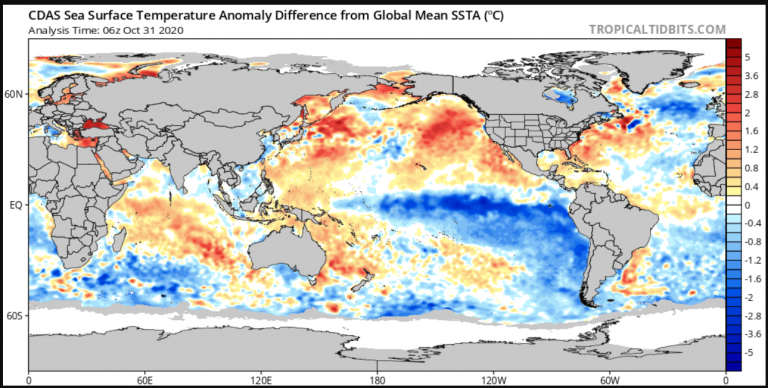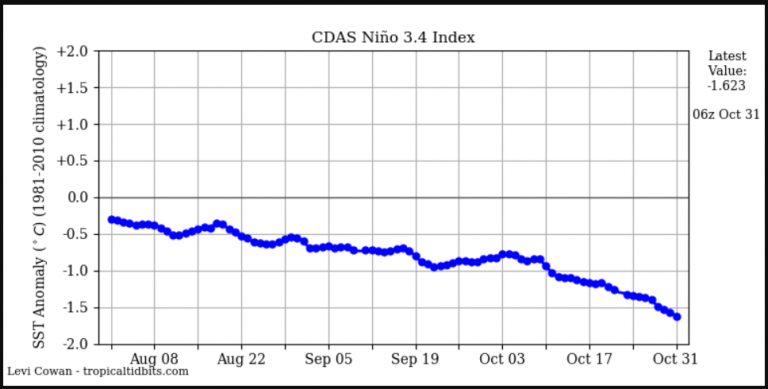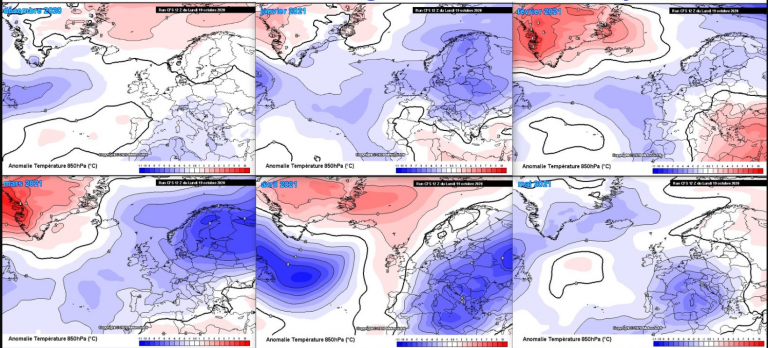Data recorded from the equatorial Pacific show a substantial La Nina in place, and falling temperatures with it.
The Australian Bureau of Meteorology (BOM) here reported on October 27: “All of the international climate models surveyed by the Bureau indicate the current La Niña will persist until at least January 2021. Most climate models reach their peak in December, before starting to weaken.”
Strong sea surface cooling developing in the equatorial Pacific. Image Tropical Tidbits
“Some models indicate that the current La Niña could possibly reach similar strength to the La Niña of 2010–12,” reports the BOM. “Sea surface temperatures in the central and eastern tropical Pacific are the coolest since the end of the La Niña event in 2012, but they are not as cool as during October 2010.”
The following chart shows the latest sea surface temperature anomaly for the Pacific El Niño equatorial regions of 3 and 4:
Image: Tropical Tidbits
The substantial La Niña event will likely cause the global mean temperature to drop a few tenths of a degree Celsius.
Low solar activity
Another factor that could spell trouble, especially for Europe, is the currently very low solar activity. Harsh European winters have been found to be linked to low solar activity.
Indeed, as in previous calculations, the experimental numerical NOAA model CFSv2 recently predicted a cold and long winter in large parts of Europe, especially from January 2021 until May 2021, see the following chart:
Source: Meteociel CFSv2 forecasts winter 2020/21 Europe
Hat-tip: SnowFan
The more recent runs have backed off a bit on the intensity of the cold.
Of course these seasonal forecasts are fraught with uncertainty, but should these come true, it could be an especially long 2020/21 winter in Europe. This would only further exacerbate the COVID-19 epidemic.
The unusual record-setting winter cold blast just seen across North America may be a trailer of what’s in store for other parts of the northern hemisphere this winter.








[…] Fonte: No Tricks Zone […]
Thanks.
EVs may struggle this winter.
Pete Parsons of Oregon has a similar outlook.
Mostly focused on OR, but there is much of interest.
https://www.oregon.gov/ODA/programs/NaturalResources/Documents/Weather/dlongrange.pdf
Buy warm socks.
Buy thermal underwear as we do in New Zealand:-)
Spring in the central South Island N E and S winds interspersed with fohn winds from the NW
https://www.metservice.com/towns-cities/locations/christchurch
Do not believe anything BOM says or writes. They have an agenda about climate change and have fiddled with past data on temperature and even rainfall. They used to measure evaporation in some areas but have stopped that because results did not agree with their agenda. They want to claim that El Nino and La Nina are part of so-called climate change caused by that terrible gas CO2. They dismiss all those El Nino and La Nina events which happened 100 or 150 years ago. SOI measurements ago back to 1860 or before. SOI based on atmospheric pressure at Darwin and Tahiti is an indicator of El Nino & La Nina. There is no indication that the situation will be like 2011 or 1974 when there were floods resulting in deaths in Queensland.
[…] Read more at No Tricks Zone […]
SPACE WEATHER IMPACTS ON CLIMATE
All weather on Earth, from the surface of the planet out into space, begins with the Sun. Space weather and terrestrial weather (the weather we feel at the surface) are influenced by the small changes the Sun undergoes during its solar cycle.
https://www.swpc.noaa.gov/impacts/space-weather-impacts-climate